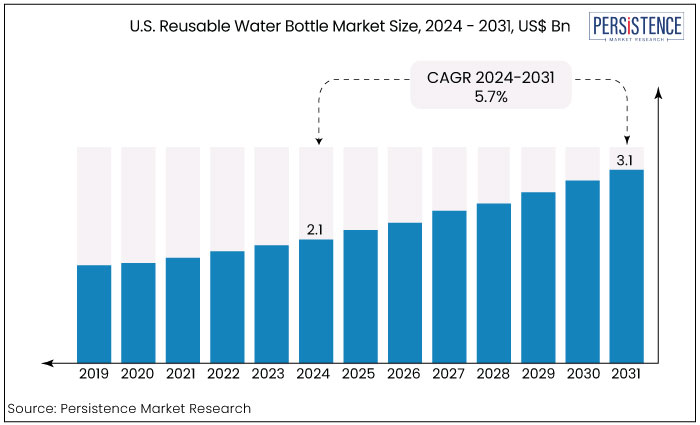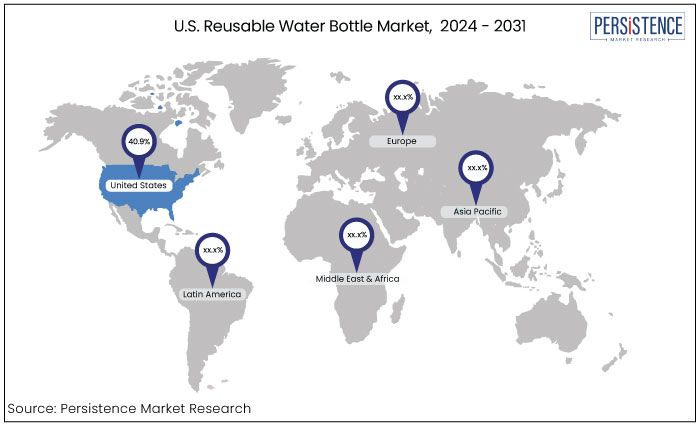U.S. Reusable Water Bottle Market
Industry: Packaging
Published Date: September-2024
Format: PPT*, PDF, EXCEL
Delivery Timelines: Contact Sales
Number of Pages: 154
Report ID: PMRREP34813
The U.S. reusable water bottle market is estimated to reach a valuation of US$3.1 Bn in 2031 from a value of US$2.1 Bn recorded in 2024. The market is estimated to capture a CAGR of 5.7% during the forecast period from 2024 to 2031. The rise in outdoor activities and fitness culture has led to increased demand for functional, durable, and stylish water bottles that can keep beverages at the desired temperature. The convenience offered by supermarkets, hypermarkets, and e-commerce platforms has also made these products more accessible.

Key Highlights of the Market
|
Market Attributes |
Key Insights |
|
U.S Reusable Water Bottle Market Size (2024E) |
US$2.1 Bn |
|
Projected Market Value (2031F) |
US$3.1 Bn |
|
Europe Market Growth Rate (CAGR 2024 to 2031) |
5.7% |
|
Historical Market Growth Rate (CAGR 2019 to 2023) |
5.2% |
|
Category |
Market Share in 2024 |
|
Material Type - Metal |
40.9% |
The metal segment of the U.S. reusable water bottle market maintains dominance with a substantial market share of 40.9% in 2024. Consumers prefer metal bottles mainly stainless steel for their durability, insulation properties, and eco-friendly appeal. These bottles are the go-to choice for daily and outdoor use as they keep beverages hot or cold for extended periods making them a top choice in the market and a reliable investment.
Metal bottles are often free from harmful chemicals like BPA, which can be found in some plastics. This safety aspect is increasingly important to health-conscious consumers. As sustainability becomes a priority for many consumers, metal bottles are perceived as more environmentally friendly. They are recyclable and often made from recycled materials, appealing to eco-conscious buyers.
|
Category |
Market Share in 2024 |
|
Distribution Channel - Supermarkets & Hypermarkets |
44.1% |
Supermarkets & hypermarkets are the dominant distribution channel in the U.S. reusable water bottle market commanding a 44.1% market share. This prominence is driven by their extensive reach, high foot traffic, and comprehensive product variety. Consumers favor these outlets for their convenience and ability to offer competitive pricing making them a key player in the distribution landscape of the market.
As consumers increasingly prioritize sustainability, many supermarkets emphasize eco-friendly products. Featuring reusable water bottles aligns with these initiatives, enhancing the store's image and attracting environmentally conscious shoppers.
The layout of supermarkets is designed to promote impulse buying. Placing reusable water bottles near checkout areas or high-traffic sections can lead to spontaneous purchases from consumers who may not have initially intended to buy one.
The U.S. reusable water bottle market is experiencing notable growth driven by increasing consumer focus on health and convenience. Available in materials like metal, plastic, glass, and silicone, reusable bottles are preferred for their practicality and varied benefits.
Current trends show a notable preference for metal bottles mainly stainless steel due to their durability and adequate insulation. Plastic bottles also hold a significant market share valued for their affordability and lightweight characteristics.
Innovation is a key driver with advancements such as improved insulation, ergonomic designs, and intelligent features for hydration tracking enhancing product appeal. Additionally, the demand for customizable and specialized bottles is on the rise. The U.S. reusable water bottle market is primarily driven by a growing consumer awareness of environmental issues and the push to reduce single-use plastics.
As sustainability becomes a core value for many shoppers, reusable bottles are increasingly seen as a practical solution for minimizing waste. This trend is further supported by health-conscious consumers seeking safe alternatives to plastic, as many metal and glass bottles are free from harmful chemicals like BPA.
Supermarkets and hypermarkets dominate the distribution landscape, contributing significantly to market sales, while online retail channels are increasing due to their convenience and wide selection. The U.S. market reflects a shift toward more functional and advanced hydration solutions.

The U.S. reusable water bottle market has demonstrated significant historical growth, driven by shifting consumer preferences towards practical and durable hydration solutions. Over the past decade, the market has expanded as reusable bottles gained popularity for their convenience and versatility. The introduction of various materials including metal, plastic, glass, and silicone has catered to diverse consumer needs and preferences.
Technological innovations such as improved insulation, leak-proof designs, and features like built-in filters have supported historical growth. This evolution has enhanced product functionality and contributed to increased consumer adoption.
The market is poised for continued expansion. Ongoing product innovations like innovative technology integration and customization options will drive future market growth.
The increasing availability of these products through diverse retail channels, including supermarkets, hypermarkets, and online platforms will also likely to drive further market advancement. The U.S. reusable water bottle market is set to continue its upward trajectory, reflecting evolving consumer demands and technological advancements.
Growing Health Consciousness and Emphasis on Hydration
Growing health consciousness and a heightened emphasis on hydration are significant drivers behind the rise in reusable water bottles. As individuals become more aware of the benefits of proper hydration for overall well-being, they increasingly seek convenient and reliable solutions.
The focus on maintaining adequate fluid intake during various activities, from daily routines to fitness routines, has led consumers to favor durable and functional water bottles. This shift is further supported by the widespread promotion of hydration as a critical component of a healthy lifestyle, prompting more people to invest in high-quality and reusable bottles.
Government Regulations Banning Single-Use Plastics
Government regulations banning single-use plastics significantly drive the growth of reusable water bottles. Increasingly stringent policies and legislative measures to reduce plastic waste encourage consumers and businesses to adopt sustainable alternatives. These regulations often include bans on single-use plastic bottles incentivizing the shift toward reusable options.
As states and municipalities implement strict rules and provide incentives for sustainable practices, there is a growing push for products that comply with these environmental standards. This regulatory environment promotes the adoption of reusable bottles and fosters innovation in product design to meet new compliance requirements and consumer preferences for eco-friendly alternatives.
Concerns About Material Quality and Safety for Health-Conscious Consumers
Material quality and safety concerns pose a restraint for health-conscious consumers when selecting reusable water bottles. Issues such as harmful chemicals, the potential for leaks, and the long-term durability of materials like plastic can impact consumer trust and purchasing decisions. Many consumers are wary of bottles made from lower-quality materials that may degrade or leach substances into the liquid over time.
Ensuring that products meet high safety standards and providing transparent information about material composition are crucial to addressing these concerns. These quality and safety apprehensions can limit the appeal of some options and influence buying choices, affecting overall adoption rates.
High Initial Cost Deterring Price-Sensitive Consumers
The high initial cost of reusable water bottles can deter price sensitive consumers. While these bottles often offer long-term savings and durability, the upfront expense compared to disposable alternatives can be a significant barrier for budget-conscious buyers.
Premium materials, advanced features, and brand names contribute to the high price point, which may lead some consumers to opt for cheap, and single-use options. This cost concern can limit the appeal of high-end products and impact overall sales particularly among those who prioritize immediate affordability over long-term value.
Innovations in Smart and Customizable Bottle Designs
Innovations in intelligent and customizable bottle designs present a significant opportunity for growth. Smart bottles with technology to track hydration levels, monitor intake, and sync with health apps offer enhanced functionality for tech-savvy consumers.
Customizable options such as personalized colors, designs, and engravings cater to individual preferences and create unique user experiences. These advancements appeal to consumers seeking practicality and personalization in their hydration solutions.
Brands can differentiate themselves and capture a large market share by integrating intelligent features and offering customization. This focus on innovation not only meets evolving consumer demands but also fosters brand loyalty and attracts new segments of buyers.
Collaborations with Fashion Brands for Trendy Products
Collaborations with fashion brands for trendy products offer a significant opportunity for growth. By partnering with well-known fashion labels, companies can create stylish, high-profile reusable bottles that appeal to trend-conscious consumers.
Partnerships can introduce innovative designs, unique patterns, and limited-edition releases that blend functionality with fashion. Such collaborations not only enhance the product's appeal but also leverage the fashion brand's market presence and consumer base. This strategy can drive higher sales and brand visibility attracting customers who value both aesthetics and practicality.
Engaging with fashion brands can position products as desirable accessories expanding their reach and fostering increased consumer interest and loyalty.
The competitive landscape of the market for reusable water bottles is marked by various players from established brands to emerging startups. Leading companies such as Hydro Flask, S'well, and Nalgene dominate with their strong brand recognition and extensive product lines.
New entrants leverage innovations in design and materials to carve out niche markets. Factors like product quality, unique features, and brand differentiation drive competition. Companies also vie for market share through strategic partnerships, advanced technology integration, and effective marketing strategies to appeal to health-conscious consumers.
Recent Developments in the U.S Reusable Water Bottle Market
|
Attributes |
Details |
|
Forecast Period |
2024 to 2031 |
|
Historical Data Available for |
2019 to 2023 |
|
Market Analysis |
US$ Billion for Value |
|
Key Market Segments Covered |
|
|
Key Companies Profiled |
|
|
Report Coverage |
|
|
Customization & Pricing |
Available upon request |
By Material Type
By Shape
By Size
By Distribution Channel
To know more about delivery timeline for this report Contact Sales

The market is estimated to increase from US$2.1 Bn in 2024 to US$3.1 Bn by 2031.
Government bans on single-use plastics is a key factor driving industry growth.
A few of the leading industry players in the market are Hydro Flask, S’well, Nalgene, and CamelBak Products.
The market is projected to capture a CAGR of 5.7% through 2031.
A prominent opportunity lies in developing smart, tech-enabled bottles with hydration tracking and personalized designs.